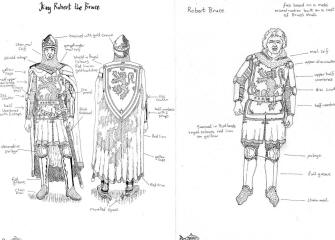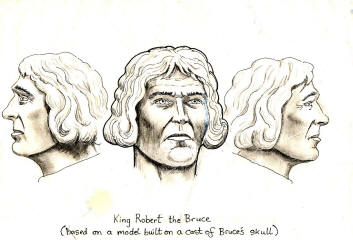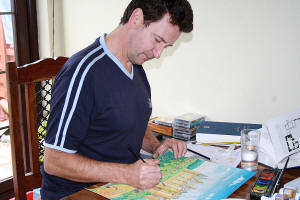The article below by
Yonnie McInness appeared in the Ayrshire Post in February
2011.
See also an explanation of the
reconstruction process by Andrew Spratt below.
Turnberry Castle and King Robert the
Bruce of Scots by Yonnie McInnes as published in the
Ayrshire Post.
The
mysterious rubble remains of Turnberry Castle surrounding
the now iconic lighthouse appear to be a confused muddle of
grassy mounds. "However in the late 13th century this site
was the great coastal stronghold of the Bruce family of
Annandale, Earls of Carrick",said Andrew Spratt, monument
manager at Dirleton Castle who, in his spare time
painstakingly researches, reconstructs, and then brings long
disappeared or ruinous castles back to life on canvas. He's
spent the last 30 years producing paintings of many such
castles around Scotland after spending the summer working
beside his father at Tantallon Castle as a teenager.
He began by
doing an ink drawing of King James's blockade of Tantallon
as his first reconstruction. Author Nigel Tranter was his
mentor and from whom he borrowed a huge library of reference
material. Andrew refers to his work as being a bit like
putting together a huge jig-saw puzzle. Old prints supply
vital clues for his reconstruction work. But, he admits,
piecing together what Turnberry Castle actually looked like
was a real challenge as there was only a few stumps of wall
remaining on the site and there were no prints to use as a
reference point.
It took
Andrew two days of mapping the site to determine that it had
been divided into two parts with a gatehouse and keep
courtyard and an upper main keep and boathouse. Andrew says
it was possible to determine what Turnberry Castle had
looked like by carefully charting, level-by-level, its
original architectural elements. "Turnberry, a stone castle,
was perched on the rocky promontory protected on three sides
by the sea and defended on the landward side by a great dry
ditch, still evident today", explained Andrew.
"Inland sat
the original village of Turnberry, with the usual collection
of wood and wattle constructed buildings with thatched
roofs. Containing houses, storage barns, stables, brewhouses
and so on. Further still inland this castle-town would have
been surrounded by a wooden palisade and protected by a
second dry ditch with wooden gate house and fixed bridge.
The stone castle itself astride its rock stacks was reached
by a drawbridge with portcullis and was divided into two
parts. A lower gatehouse/keep and courtyard but also an
upper Keep with D-plan tower and an unusual lean-to
boathouse with seaward access for supply vessels, guarded by
a huge seagate portcullis. "
"In theory
if the castle-town and castle courtyard fell during a siege,
this boathouse could be used as a means of escape for the
castle garrison if all else failed. Strangely the reverse is
true of this defensive feature. When in 1307 King Robert the
Bruce of Scots (1306-1329), entered Turnberry by way of this
boathouse taking the unwelcome English garrison totally by
surprise. The ancient site of Turnberry was originally held
by the old Celtic Lords of Galloway, early Earls of Carrick
during the reign of King William I of Scots( 1165- 1214). "
"The castle
may have been started by Duncan or his son Neil, who died in
1256. Neil's daughter Marjorieor Margaret married Robert de
Brus (father of king Robert). & thus Turnberry passed to the
Bruces,who added to the site. It should also be noted that
Turnberry may be the birthplace of King Robert but other
accounts claim he was born at Lochmaben castle (the wooden
motte not the stone castle). Rather oddly Turnberry was
burnt in 1297 by William le hardy Douglas. "
|
 |
 |
|
King Robert the
Bruce as he may have looked in heraldic dress |
King Robert the
Bruce based on a model
built on a cast of Bruce's skull |
"The young
Earl of Carrick (later King Robert) retaliated by burning
the lands in Douglasdale and capturing Douglas' wife and
young son James.Who ironically became the legendary Good Sir
James the Black Douglas who carried King Robert's heart to
Spain at the battle of Teba in 1330. Which was where Douglas
died but the heart was returned to Scotland and buried at
Melrose Abbey. "
"In 1301
the English invaders seized Turnberry but were unable to
stop the Scots in Carrick revolting and fled to King Edward
I's (Hammer of the Scots) camp at Linlithgow, leaving token
garrisons at the castles of Ayr and Lochmaben. In October
1301 the Constable of Ayr complained in a letter to King
Edward that the Scots of Carrick were before the walls of
Turnberry,with 400 men-at-arms and within these eight days
wanted to attack Ayr. In February 1302 Ayr Castle was
besieged by the Scots but with little success. Sadly Robert
Bruce had already surrendered to King Edward, before
revolting again later. "
"And in
1307 he took Turnberry presumably slighting it preventing it
and all other castles taken in the lowlands from being used
as footholds and staging posts for the invading English.
This policy paid off when in 1314 a massive overstretched
English army snaking its way to Stirling were defeated at
the battle of Bannockburn by King Robert the Bruce of
Turnberry".
The Reconstruction of Turnberry
Castle by Andrew Spratt
 In
1999 I spent two days mapping the site around Turnberry
taking measurements,checking wallings for gateways,marks of
portcullis grooves,windows,doorway footings,signs of
turnpike stair wells showing a building was more than just
one storey high etc. I also took many slide shots as I used
these views, not only in my finished slide shows but as a
tool to help rebuild the castle reconstruction as near
accurate and to scale as possible. In
1999 I spent two days mapping the site around Turnberry
taking measurements,checking wallings for gateways,marks of
portcullis grooves,windows,doorway footings,signs of
turnpike stair wells showing a building was more than just
one storey high etc. I also took many slide shots as I used
these views, not only in my finished slide shows but as a
tool to help rebuild the castle reconstruction as near
accurate and to scale as possible.
To explain I
projected a slide of the ruin onto an A3 sheet of plain
paper. I then pencil round the outline noting the location
of walls/towers and land features. Then using the two day
mapping measurements I draw the reconstruction in black
pen,using a ruler since these elements have to be measured
exactly to fit the site. Its as if I were rebuilding the
castle level by level right,stone by stone right up to roof
level, uing examples of more intact towers from all over
Scotland. Its guess work but educated guess work.
The next
stage was to use the A3 pencil/pen drawing as a template to
trace through onto a sheet of embossed water-colour paper.
While detailing the finished painting I again projected the
slide from time to time checking colours and shading match
for the whole building. By doing the reconstruction in these
stages instead of simply drawing free hand there are less
chances of mistakes in the finished work.
Also because
there was a question mark over the castle courtyard because
of the position of the modern light house. I stuck to the
site strengths cheating slightly by only doing views from
the side and seaward view,because I was totally sure of the
position and form of the Gatehouse,D-Plan tower and
Boathouse leaving what was uncertain hidden from view.
Hopefully I
have contributed something of worth to Scottish history in
my reconstructions of Scottish castles and battles. I have
tried to breath life back into ancient ruins like Turnberry
to show real people lived there. Castles like Turnberry were
symbols of status,wealth and power. Not only were they
family homes providing protection for local surrounding
villages. But were used as war platforms for launching
attacks on other nearby hostile power hungry families. I've
tried to make history more interesting for children in my
drawings,talks and costumed tours in an attempt to bring
history to life in a fun and entertaining way. Like Nigel
Tranter always said "putting the story back into history". I
hope I have contributed something towards that goal.
|